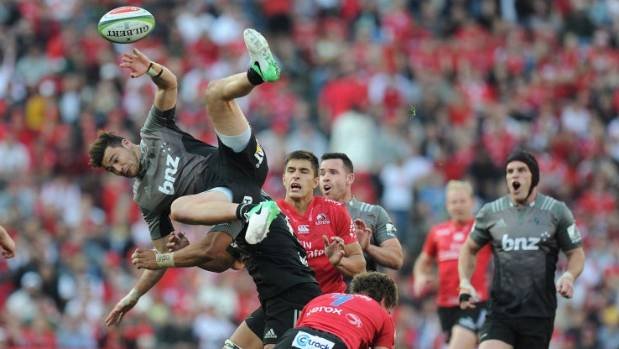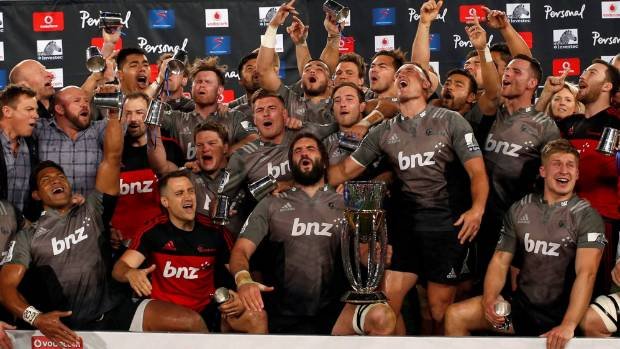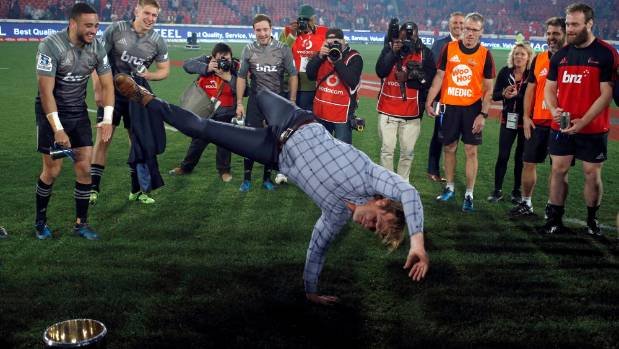
SteemSports Presenter: @sportsdesk
SteemSports General Manager: Nolan Jacobson, @theprophet0
Preview
This was the first super rugby final to be played in Jo’burg. Seven-times super rugby champions Crusaders travelled to the republic for their 12th appearance in a super final. For the Lions this was their second final (in consecutive years). The Crusaders hadn’t won a title since 2008 while the Lions were hoping to secure their first. Both teams had won all but one game during the regular season, were the top two performing teams and deserved finalists.
It was a beautiful winter’s day, bright sunshine, with temperatures cooling off as the shadows fell over the ground prior to the start. It was a great sight as 63,000 Lions fans (with presumably a smattering of Crusaders fans) packed out Ellis Park. Both teams fielded unchanged squads from their semi-final matches.
The Final in Action
Both teams traded blows in the opening exchanges. The Lions dominated possession but as had become their trademark, the Crusaders defense held strong. Their defensive line speed frustrated the Lions to the point Jantjies was forced into trying an optimistic drop goal after 5 minutes.
It was defensive pressure that lead to the Crusaders first try in the 8th minute. The Lions had plenty of ball but were proving easy picking for Crusaders defence with their one-off runners. A big tackle by Read on Jantjies allowed the Crusaders to turnover the ball, it was quickly moved to Tamanivalu who found open space ahead of him and ran the length of the field to score. Mo’unga coverted. Crusaders 7-0.
The Lions problems compounded as Jantjies kicked the restart into touch. From the resulting Crusaders scrum at halfway, they spun the ball wide both ways as they headed quickly upfield. They created space out wide as the Lions defence scrambled back, and slick handling saw Goodhue crash over in the corner. Two opportunities, two tries. The Crusaders were so so clinical. 12-0.
The Lions continued to probe and push, using a lot of dummy runners but the Crusaders defence held firm. And inevitably defensive pressure brought about a mistake. Even a Lions big weapon - the driving maul, was being repelled.
All the Lions had to show for their first half effort was a Jantjies penalty attempt from 50m to bring the score to 12-3. That was until the 38th minute collision between Kwagga Smith and David Havili saw Smith be sent for an early shower. The Lions had decided to change tactics and opted for a high kick. As Havili went up to catch the ball, Smith took him out in the air and Havili came down on his neck. Ref Peyper, under the new laws that a player in the air must be protected, had no option but to show him red. The Lions had to play the remainder of the game with 14 men.
Just on halftime Mo’unga slotted another penalty for the Crusaders to take a 15-3 lead. The Crusaders scrum was monstering the Lions scrum, the last penalty a result of this dominance. The statistics showed the Lions had the wealth of possession and territory in the first half, however they failed to fire a shot. Contrast to this, the Crusaders were clinical on both attack and defense, and held a deserved lead.
The opening period of the second half was a repeat of the first. The Lions continued with one-off runners from the breakdown, and eventually the Crusaders defense force an error. From one such error, the Crusaders swung onto attack, a kick-pass by Crotty to Dagg took them to the line, quick ball from the breakdown was spun through the hands and Read crashed over in an ineffectual tackle under the posts in the 53rd minute. Mo’unga converted. 22-3. The crowd went silent. The Lions appeared to have run out of ideas on attack and started kicking the ball away. From another scrum penalty, Mo’unga kicked the goal. 25-3.
Finally in seeming desperation, the Lions started to throw it wide at pace and looked more dangerous. Excellent lineout work by the Crusaders prevented any initial reward as they thwarted the attacks. Eventually the pace of the game at 1700m started to run the way of the Lions. With quick recycling from the breakdown, they had Marx over in the corner. Jantjies converted. 25-10. The Lions sniffed a chance and upped the tempo. The Crusaders were now running on fumes. With 10 minutes to go, the Lions piled onto attack. Slick ball handling through multiple phases wore down the Crusaders defense and the Lions crashed over for a second try, this time under the posts. Jantjies converted, 25-17. Game on.
The closing minutes were frenetic. The Lions spun it wide from the restart, went through 12 phases but the Crusaders defence kept them pinned in their own half. A couple of penalties to the Lions saw them move deep into Crusaders territory. The Lions had a lineout on the Crusaders 22m but typifying the game, the Crusaders stole it. It was helter skelter attack from the Lions to the death but the Crusaders defense wasn’t to be breached.

The Final Wrap
Seven times super rugby champions became eight times super rugby champions. The Crusaders were dominant, accurate and clinical. Their work at set-piece, attacking the Lions on their own throw or scrum put-in was paramount to their defensive effort. It was a courageous effort from the Lions, not just for the final but for the wonderful season they’ve had. What difference the red card made to the final result is academic but the Lions have to be admired for how they never gave up and fought back in the second half to make it an enthralling spectacle.
However the final word must go to the Crusaders (& their coach). No team had ever traveled across the Indian Ocean and won a final, but Scott Robertson’s men changed that. He had won four super titles as a Crusaders player between 1999-2002, and has now become the first to win a title as both a player and a coach.

